The surfacing needs of today’s engines are as complex as the engines themselves. Multi-valve aluminum cylinder heads on cast iron blocks are a tough combination to seal because of the difference in expansion rates between the two metals. If the surface finishes on the head and block are too rough, lateral shearing forces which occur as the engine heats up and cools down can literally scrub a head gasket to death.
To handle such forces, a growing number of late model engines now use multi-layer steel (MLS) head gaskets. These include many Ford, Chrysler, Honda/Acura, Mazda, Mitsubishi, Nissan, Subaru and Toyota engines, plus Jeep 4.7L V8 and Volkswagen 2.0L SOHC engines. MLS gaskets typically have 3 to 5 layers of steel and are extremely tough. But they have little conformability and require a very smooth finish on both the block and cylinder head to seal properly. OEM specifications vary, but surface finish requirements for MLS head gaskets typically range from 15 to 30 microinches Ra or less.
The ability to duplicate OEM surface finishes is a must on these applications, especially if OEM style MLS gaskets are being installed in the engine. Some aftermarket replacement gaskets for these engines have a thicker surface coating that can accommodate a more “traditional” surface finish of up to 60 microinches Ra. But most MLS replacement gaskets require the same surface finish as the original – which means engine builders must have surfacing equipment that can duplicate a finish that meets OEM specifications.
MLS gaskets have also become very popular in racing. Most NASCAR engines today are running MLS gaskets, and the people who are putting these engines together typically want finishes in the low teens or even single digits! That level of smoothness can only be obtained with equipment that has the rigidity, accuracy and control flexibility to produce an ultra-smooth finish.
A number of things are required to achieve a really smooth finish. One is that a surfacer must allow the right combination of cutting speed and feed rate to achieve really low numbers. If the feed rate is too fast or the cutter spins too slowly, the finish may be too rough. Surfacers with multi-bit cutters can handle much faster feed rates than a surfacer with only a single bit cutter – but the tradeoff is higher tooling and maintenance costs, plus more time to set up and adjust multiple cutting bits.
A feed rate of two inches per minute at 1,000 rpm with a two-bladed cutter will typically give a surface finish in the low teens. Increase the feed rate, decrease the rpm or use a single-bladed cutter and the numbers go up. To get the same finish with a single cutter head, the feed rate has to be cut in half to one inch per minute at the same 1,000 rpm cutting speed.
Smooth surface finishes can be achieved with any kind of cutting bit including carbide, CBN or PCD, but carbide obviously wears faster and requires more frequent replacement. The economics of carbide versus PCD or CBN will depend on the volume of work that’s being done, the type of heads being resurfaced (cast iron, aluminum or both), the number of bits per cutter and the cost per bit. Many shops have gone away from carbide and are now using CBN and/or PCD. In the past, PCD was recommended for aluminum and CBN for cast iron. But many shops report having success using CBN alone for both metals.
Shopping Features
Buying a new surfacer obviously requires a sizable investment, anywhere from around $12,000 up to $50,000 or more depending on the tooling, fixturing, bells and whistles. The higher the price, the more features you get like programmable controls, multi-bit cutter heads and multiple capabilities. Some machines are dedicated surfacers while others are dual-purpose machining centers that can also be used as a valve and seat machine. Others are combination boring/milling machines.
A dual-purpose machine gives you increased flexibility and takes up less floor space but limits you to performing one type of job at a time. Dual purpose machines are ideal for smaller low volume shops but may not be the best choice for a larger, high volume shop. With a dedicated surfacer, you can be resurfacing at the same time you’re doing other jobs on other machines.
One thing to look for in a surfacer that is designed for high speed CBN/PCD tooling is rigidity. Superabrasives cutting at high speeds do not like any vibration or harmonics. They must be stable to cut evenly and cleanly. So look for a rigid table, power head and a large diameter shaft for the cutter head. Size does matter when it comes to increased rigidity.
The type of feed mechanism the surfacer uses is also important. Hydraulic surfacers have been around for many years and offer infinitely variable feed speeds. A hydraulic feed uses pressure to push the table along on slides. At low feed rates, though, the table may stick momentarily as it moves, creating a “stick and slip” motion that may leave an uneven finish on the head or block. That’s why many surfacers now have electric drive ball screw feed mechanisms. A motor driven ball screw mechanism provides a higher degree of control and consistency which helps the machine achieve ultra-low Ra surface finish numbers.
Ease of setup and ease of operation are also features you want in a new surfacer. This includes both fixturing and controls. The fixturing should be capable of accommodating a wide variety of different cylinder head configurations as well as different lengths. If all you do are passenger car and light truck engines, all you need is a standard sized surfacer with fixturing for these applications. On the other hand, if you do heavy-duty diesel heads and/or blocks, you’ll need a larger machine with oversized fixturing to handle the larger parts.
Ease of setup includes being able to mount a head or block on the surfacer quickly, level it and align the cutter head. The “Winfield” fixture is very popular and can accommodate both heads and blocks. It usually takes only 5 to 8 minutes to set up, which can really save a lot of time in a busy shop. Less expensive universal “economy” fixtures are also available, and may save you some money up front. But you also have to consider what your needs really are and which type of fixturing will best meet those needs year-round in your shop. You also have to compare set-up times and how it affects productivity.
Setup accuracy is absolutely essential because there’s little margin for error on most engines today. In most cases, you will be removing very little metal and just skimming across the surface to clean it up. Some surfacers have a built-in dial indicator that makes it easier to set up the machine. Time is money and the less time it takes to set up a cylinder head or a block to be resurfaced, the more time can be spent resurfacing metal. Faster turn around means more production and hopefully more profit at the end of the day.
Programmable controls and automated operation are also features that are nice to have. You pay extra for such capabilities, but you get a lot in return. Programmable controls reduce machining errors and allow the operator to do something else instead of babysit the equipment. The more sophisticated machines compensate for cutting bit wear and automatically figure the best combination of cutting speed and feed rate to achieve a particular surface finish. They also provide greater consistency from one job to the next.
What’s New
Like other pieces of shop equipment, surfacing machines continue to evolve to meet the changing needs of today’s engines as well as today’s market. Almost every supplier now offers equipment that is designed for CBN/PCD tooling, faster cutting speeds and low Ra finishes. Some supplies have also introduced “economy” versions of popular machines to appeal to buyers who want a certain level of capability but who can’t afford all the features that may be included in a particular machine. The economy surfacers may be scaled down slightly or include fewer standard features than the higher priced models.
CWT INDUSTRIES
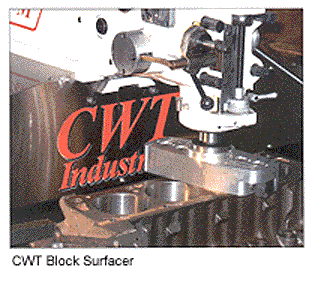
Randy Neal of CWT Industries, Norcross, GA, says the PRO1058 is his company’s standard machine for resurfacing heads and blocks. The surfacer is an “industrial quality” machine with adjustable spindle speed and transverse speed, and a cutter head that can accept carbide, PCD or CBN. Neal says this machine can achieve ultra-smooth finishes (down to 7 Ra ) with the right kind of carbide tooling at one-tenth the cost of PCD or CBN.
“A lot of machines that have 10?, 12?, 14? or 18? flycutters can’t do manifold surfaces. The tool holder on our machine can be easily changed so if you need to do a manifold surface you can do it. Flexibility is the key with this surfacer,” said Neal.
SUNNEN/DCM TECH
Because Sunnen Eqpt. Co., St. Louis, MO markets both the DCM product line as well as Sunnen’s own machines, the lineup of available equipment includes six different surfacers:
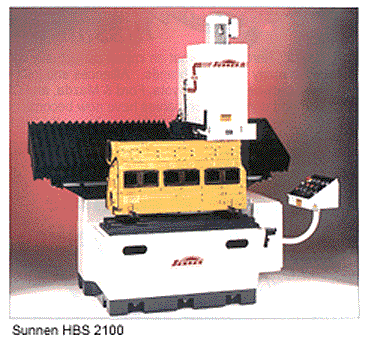
Sunnen’s Tim Meara explains that their best-selling model is the Model 3810. It is a basic surfacer that can use CBN or PCD tooling, has a ball screw drive with both vertical and horizontal feed and can also be used as a grinder. The machine is available with three different fixturing options.
Model 3820 has the same capacity as the 3810 but has a programmable drive that can be used for multiple cuts and automatic cycling. This surfacer is popular with racers because of its highly accurate controls and ability to achieve finishes as low as 4 microinches Ra.
HMC-3000 is a dual-purpose machine that be used as a surfacer or guide and seat machine. It can accommodate heads up to 38? in length.
HM-5410 is a larger surfacer for diesel heads up to 54? long. The cutter head is 18? in diameter and holds two bits (CBN or PCD). The machine has a ball screw drive mechanism, and can also be used for grinding (which Meara says works better than cutting when nickel/carbide hardened cylinders or liners are installed in diesel blocks).
HM-5400 is similar to the HM-5410 except that it has a hydraulic feed.
HBS-2100 is a ball screw drive surfacer with both horizontal and vertical feed with a fixed table. The cutting head can accept 12 carbide bits, or PCD or CBN cartridges. It also includes a touch-off indicator for setting up heads.
PETERSON
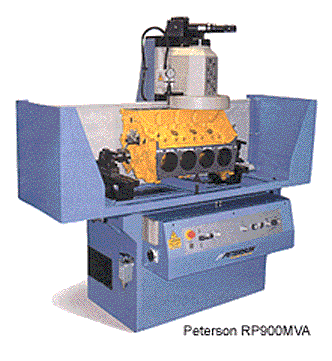
Chip Brown of Peterson Machine Tool in Shawnee Mission, KS, explains that Model 900MVA is the company’s most popular surfacer. The base price includes a ball screw driven table with variable transverse speed, auto lift and retract system, push button operation and automatic return. The machine can handle heads up to 35? in length and blocks up to 18-1/2? high. The machine has a 14? cutter head for CBN or PCD bits.
For larger diesel engines, the Model RP1200M can resurface heads up to 46? long and blocks up to 23-1/2? tall. The table transverse speed is variable and the cutter head turns at 1,750 rpm.
For grinding, the Model RG300/900P can do heads up to 35″ long.
RMC ENGINE REBUILDING EQUIPMENT
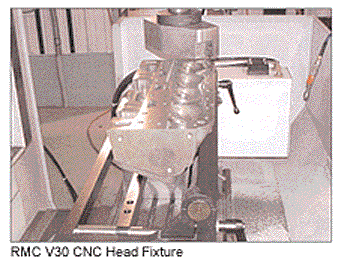
Ray Meyer of RMC Engine Rebuilding Equipment in Saginaw, MI, said his company has updated the CNC programming on its RMC B30 CNC surfacer to optimize it for surfacing with CBN and PCD tooling. The basic unit is a full machining center that can be fitted with a $2,995 surfacing add-on for automated resurfacing of blocks and heads. The cutter head uses two bits and runs at 2,900 rpm to produce finishes as smooth as 10 Ra.
The RMC10V is the company’s basic surfacing machine. It is an entry level surfacer and does not have CNC controls. It can handle heads and blocks up to 40? in length and uses a variable hydraulic feed drive for the table.
ROTTLER
Anthony Usher of Rottler in Kent, WA, says Rottler’s surfacers use electric ball screw feeds for greater precision. The “SF” Series models feature “closed loop” electronic gearbox controls that combine the spindle rotation speed and feed rate for a certain Ra finish. A less expensive manually operated model is also available. Surfacers are also available in two different sizes: one for passenger car engines and one for diesels.
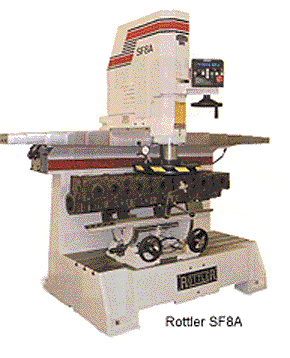
Usher said his surfacers are priced competitively, and that customers now have a choice on fixturing: $4,500 for their standard fixturing or under $3,000 for their economy universal fixturing.
Usher said Rottler recently sold a resurfacer to Hendrick Motorsports (Jeff Gordon’s NASCAR NEXTEL Cup Series team) after proving how much smoother they could make their heads and blocks with updated equipment.
“With their old equipment, Hendrick Motorsports was getting finishes in the 25 to 30 Ra range, a range that was okay but not as good as it could be. By increasing the cutting speed to 2,000 rpm and using larger 1/2? diameter PCD inserts, Rottler’s new machine could give them finishes as low as 3 to 5 Ra,” said Usher. “Their first reaction was, ‘It’s too smooth.’ Then they realized how much better a seal they could get with the smoother finish.”
STORM VULCAN
Terry Wagner at Storm Vulcan said his company is introducing a brand new surfacer that will be available in the next few months. The imported machine is manually operated with a hydraulic table, has a power raise head and can accommodate heads up to 45? in length. The machine will be set up for CBN/PCD and grinding, and includes fixturing and tooling.
For those who use carbide, the Style 85 resurfacer is a good choice with its 8 carbide bit cutter head and variable speed and feed. This machine can do blocks and heads, is capable of producing finishes of 15 Ra or less.
T & S MACHINES
Tim Whitley of T & S Machines in Gainsville, TX, said he is coming out with a lower-priced version of his TS3000 Block-Mate surfacer, which can handle heads up to 38? in length. Whitley says the current machine has a universal cradle that works on almost anything and is very fast to set up thanks to the built-in dial indicator. It is a single pass machine that uses a single CBN bit (PCD can also be used in the surfacer if it is only used for resurfacing aluminum heads and blocks).
The new lower priced model, which will be available later this year, will have a movable table instead of cutter head. Surface finish capabilities will be the same on the new machine, he says.
WINONA VAN NORMAN
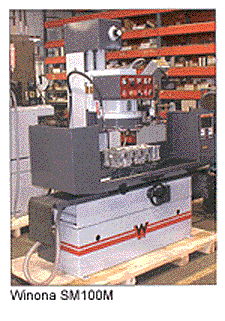
Paul Enegren, International Sales Manager, says Winona Van Norman uses an electric drive ball screw feed on its “SM” Series surfacers to get high quality, low Ra finishes. Several different models are offered including single purpose milling machines and combination milling/grinding machines.
The SM100M (milling only) and SM100 (milling/grinding) machine can handle heads up to 39? in length, the SM130 and SM130M machines can handle heads up to 45? in length, the SM160 can accommodate heads up to 57? in length, and the SM200 can do heads up to 71? in length.
All machines except the SM200 have a 13.5? milling head. The SM200 has an 18? head. The cutter holds two CBN, PCD or carbide bits, which reduces harmonics and allows faster cutting speeds. The universal Winfield fixturing allows fast and easy setup.













